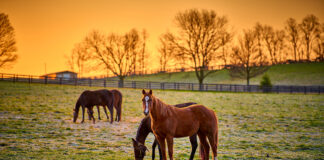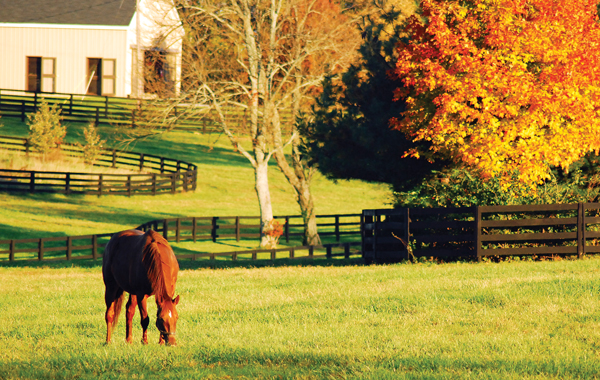
As you gaze out at your horse’s field, it’s evident that winter is coming. The once-green color of lush grass is fading to varying shades of autumn brown. You may be thinking that this fall forage is now ok for your horses to graze on full time—even those individuals that tend toward obesity. But you would be wrong.
Let’s look at some of the reasons for this and what you can do to protect your horse.
What is Fructan?
Plants, and in particular cool-season grasses, store their energy from photosynthesis in the form of starch and sugars, such as fructan. These sugar and starch energy sources in plants are referred to as non-structural carbohydrates (NSC), a term you may recognize from labels of commercial horse feeds that state “low NSC.”
Fructan concentrates in the lower part of the plant, particularly the stems—the very target of grazing horses. The sweeter the grass, the more appealing it is to a horse’s tastebuds.
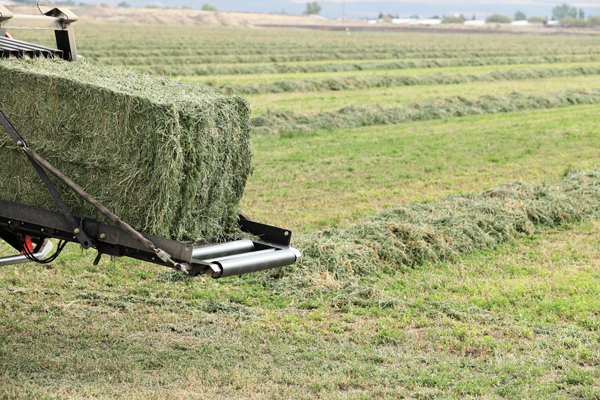
Examples of cool-season grasses include tall fescue, perennial ryegrass, Kentucky bluegrass, orchard grass and meadow fescue. Fescue and ryegrass have the highest fructan levels.
In the autumn, nights get colder and fall forage plant growth slows. Yet photosynthesis continues during the sunny hours, with cool-season grasses continuing to accumulate more fructan in the stems. Ambient temperature, light, and moisture determine the amount of fructan produced.
For example, as photosynthesis ramps up during daylight hours, sugar content in the grasses increases, so what may have started as low levels of fructan in the morning elevates to higher levels by afternoon. (This is true for all times of year, but particularly so in fall months when plant growth slows.) Knowing this time frame for the highest sugar content helps you decide when is best to turn your horse out to graze.
Another concern is hay that has been cut and left on the field to dry before baling. Mown grass continues to photosynthesize and produce NSCs for a couple of days while lying in the field to dry.
Hay is likely to have less sugar if cut at night. Hay can be tested to determine its NSC levels, which ideally should be less than 10 percent. Testing for NSC levels is particularly helpful for horses that need careful management of their
weight, like those that are insulin resistant, cresty, and tend to be fat and affected by equine metabolic syndrome. Talk to your veterinarian, a local equine nutritionist, or agriculture extension agent about where to send hay samples for
analysis.
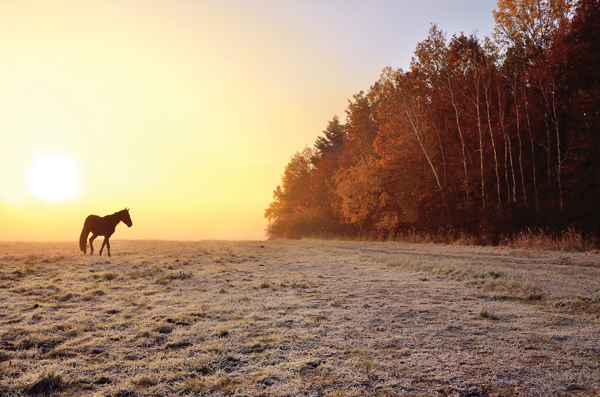
Why is Fructan Bad?
Fructan is composed of a chain of molecules that is resistant to digestion in the small intestine. It passes undigested into the large intestine, where it ferments to produce substances that lower the pH of the hindgut.
This acidic environment results in a die-off of healthy gut microbes. One of these bacteria has a cell wall called endotoxin; death of these bacteria amplifies the presence of this toxin.
An acidic environment also can injure the intestinal lining, leading to “leaky gut syndrome.” This is where toxins and bacteria from the gut absorb into the bloodstream through the intestinal lining.
This leads to system-wide inflammation and a number of potential health problems, such as laminitis, colic and/or colitis.
What Increases Fructan Levels?
Fructan levels in pasture rise during rapid growth in springtime and on rainy days in spring and autumn that encourage growth of the plants. The most fructan is produced when days are warm and sunny.
Cool-season grasses that are stressed are more likely to increase their fructan content. Grass tries to compensate for environmental stress by producing more sugars to help with growth. Pasture stress happens under a variety of conditions:
◆ Drought
◆ Temperatures below 40 degrees Fahrenheit, such as for fall forage
◆ Frost is reported to triple fructan content in just a few hours
◆ Over-grazing
◆ High soil salinity
◆ Under-fertilized pasture that is lacking in nutrients
Winter is Coming
It’s not uncommon for horses to founder even on fall forage or winter pasture. It helps to know what to look for: Wet or snowy conditions on top of pasture can stimulate plant growth on warming days, even during the winter months.
It’s a good idea to walk the pasture and look for green shoots popping up in your fall pasture, as these are likely to be high in fructans. Even though the grass over these shoots is brown and dead, there is still a risk of fructan intake from the sprouting grass hidden below the upper dead grasses.
Armed with this knowledge, you can successfully manage your horse’s dietary needs as pasture quality diminishes with the onset of colder temperatures. Sound pasture management goes a long way toward keeping your horse in the perfect body condition without negatively affecting his metabolism or gut health.
Smart Pasture Management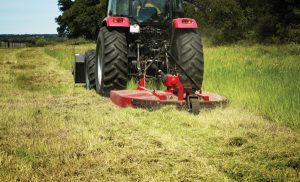 ◆ DO mow your pasture between 4 and 8 inches tall so photosynthesis by the plant will be directed into leaf growth rather than sugar storage. It’s best not to over-mow. |
This article about fall forage originally appeared in the October 2019 issue of Horse Illustrated magazine. Click here to subscribe!




